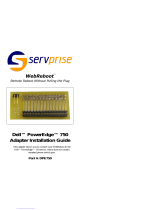
Installing an optional GPU card...............................................................................................................................122
Internal dual SD module (optional)............................................................................................................................... 124
Removing the optional internal dual SD module................................................................................................... 124
Installing the optional internal dual SD module .................................................................................................... 126
Internal SD card.............................................................................................................................................................. 128
Removing an internal SD card.................................................................................................................................128
Installing an internal SD card...................................................................................................................................128
Processors and heat sinks.............................................................................................................................................129
Removing a heat sink...............................................................................................................................................129
Removing a processor............................................................................................................................................. 130
Installing a processor................................................................................................................................................133
Installing a heat sink................................................................................................................................................. 135
Power supply unit........................................................................................................................................................... 137
Hot spare feature......................................................................................................................................................138
Removing an AC power supply unit....................................................................................................................... 138
Installing an AC power supply unit..........................................................................................................................139
Wiring instructions for a DC power supply unit....................................................................................................140
Removing a DC power supply unit......................................................................................................................... 143
Installing a DC power supply unit............................................................................................................................143
Removing the power supply unit blank..................................................................................................................145
Installing the power supply unit blank.................................................................................................................... 145
System battery............................................................................................................................................................... 146
Replacing the system battery................................................................................................................................. 146
Hard drive backplane......................................................................................................................................................147
Removing the hard drive backplane.......................................................................................................................148
Installing the hard drive backplane.........................................................................................................................165
SD vFlash media card (optional)...................................................................................................................................172
Replacing an optional SD vFlash media card.........................................................................................................173
Control panel assembly.................................................................................................................................................. 173
Removing the control panel assembly....................................................................................................................173
Installing the control panel assembly......................................................................................................................175
System board.................................................................................................................................................................. 177
Removing the system board....................................................................................................................................177
Installing the system board......................................................................................................................................178
Trusted Platform Module................................................................................................................................................181
Installing the Trusted Platform Module...................................................................................................................181
Initializing the TPM for BitLocker users.................................................................................................................182
Initializing the TPM for TXT users..........................................................................................................................182
Power interposer board and power distribution board.............................................................................................. 183
Removing the power interposer board.................................................................................................................. 183
Removing the power distribution board................................................................................................................ 184
Installing the power distribution board...................................................................................................................185
Installing the power interposer board.....................................................................................................................186
8 Using system diagnostics........................................................................................................................... 188
Dell Embedded System Diagnostics.............................................................................................................................188
6
Contents






















